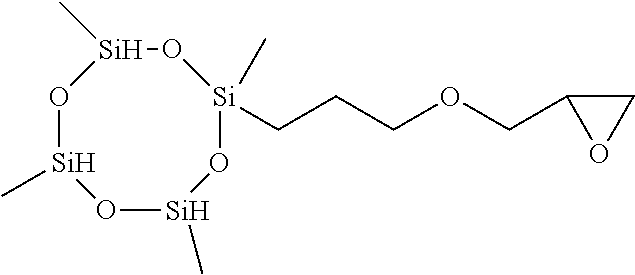Addition curable type silicone resin composition, process for producing composition, and optical semiconductor apparatus
a silicone resin and composition technology, applied in semiconductor devices, semiconductor/solid-state device details, solid-state devices, etc., can solve the problems of increased temperature around led devices, deformation of sealing materials, increased volume, etc., and achieves less change in hardness, excellent transparency and heat discoloration resistance, suitable rubber hardness
- Summary
- Abstract
- Description
- Claims
- Application Information
AI Technical Summary
Benefits of technology
Problems solved by technology
Method used
Image
Examples
synthesis example 1
Synthesis of Component (e)
[0071]To 100 parts by mass of dimethylpolysiloxane both terminals of which had been sealed by trimethylsiloxy groups and having a viscosity at 25° C. of 100 mPa·s was added a material in which 10 parts by mass (mass of cerium: 0.55 part by mass) of a turpentine solution of 2-ethylhexanoate comprising cerium as a main component (content of rate earth element: 6% by mass) and 2.1 parts by mass (mass of titanium: 1.65 parts by mass) of tetra-n-butyl titanate have previous been mixed while sufficiently stirring, to obtain a yellowish white dispersion. Turpentine was discharged therefrom by heating while flowing a small amount of nitrogen gas, and then, the mixture was heated at 300° C. for 1 hour to obtain a homogeneous composition of deep reddish brown transparent polyorganometallosiloxane (e1). The Ce content of the thus synthesized polyorganometallosiloxane (e1) was 3,400 ppm, the Ti content thereof was 3,700 ppm, and the viscosity thereof at 25° C. was 104 ...
example 1
[0072]A linear dimethylpolysiloxane (a1) both terminals of which are sealed by vinyl groups and having a viscosity at 25° C. of 5,000 mPa·s, and a toluene solution of a solid state silicone resin (b1) constituted by an Me3SiO1 / 2 unit, a ViMe2SiO2 / 2 unit, and an SiO4 / 2 unit, a molar ratio of the Me3SiO1 / 2 unit and the ViMe2SiO1 / 2 unit to the SiO4 / 2 unit being 0.8, and an amount of the vinyl group based on the solid component being 0.085 mol / 100 g were mixed with a ratio of the dimethylpolysiloxane (a1):the silicone resin (b1)=75:25 in a mass ratio in terms of the effective components. Toluene was removed from the mixture at 120° C. under reduced pressure of 10 mmHg (about 1.3 kPa) or lower, to obtain a liquid which is transparent at room temperature.
[0073]Next, with 100 parts by mass of the liquid were mixed 2.57 parts by mass of methyl hydrogen polysiloxane (c1) having an average composition formula (2): R4aHbSiO(4-a-b) / 2 wherein, R4 is a methyl group, a=1.4, b=0.8, and both termina...
example 2
[0075]The same procedure as in Example 1 was carried out except for changing the formulation amount of the polyorganometallosiloxane (e1) obtained in Synthesis Example 1 to 2 parts by mass, to obtain a transparent addition curable type silicone resin composition having a viscosity of 4,800 mPa·s.
PUM
| Property | Measurement | Unit |
|---|---|---|
| viscosity | aaaaa | aaaaa |
| viscosity | aaaaa | aaaaa |
| viscosity | aaaaa | aaaaa |
Abstract
Description
Claims
Application Information
 Login to View More
Login to View More - R&D
- Intellectual Property
- Life Sciences
- Materials
- Tech Scout
- Unparalleled Data Quality
- Higher Quality Content
- 60% Fewer Hallucinations
Browse by: Latest US Patents, China's latest patents, Technical Efficacy Thesaurus, Application Domain, Technology Topic, Popular Technical Reports.
© 2025 PatSnap. All rights reserved.Legal|Privacy policy|Modern Slavery Act Transparency Statement|Sitemap|About US| Contact US: help@patsnap.com


